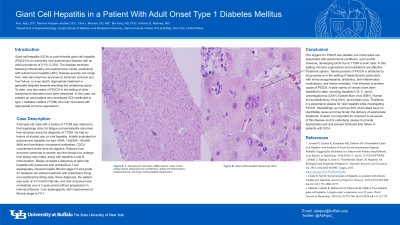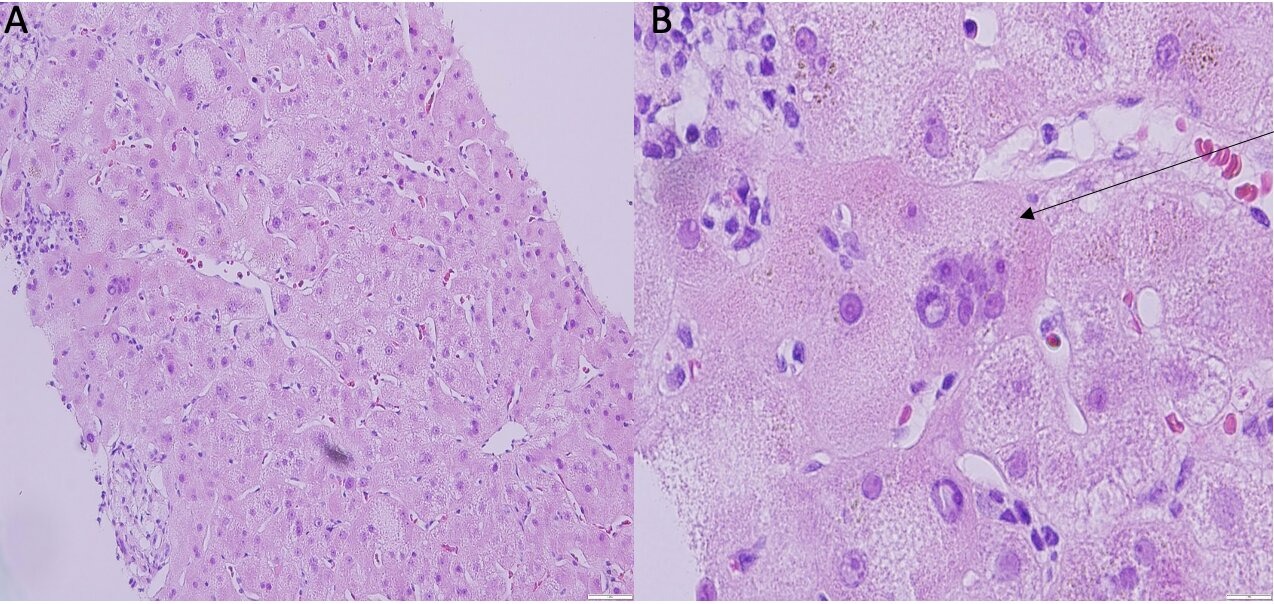Monday Poster Session
Category: Liver
P2481 - Giant Cell Hepatitis in a Patient With Adult Onset Type 1 Diabetes Mellitus
Monday, October 23, 2023
10:30 AM - 4:15 PM PT
Location: Exhibit Hall

Has Audio
- AA
Ali A. Aijaz, DO
University at Buffalo
Buffalo, NY
Presenting Author(s)
Ali A.. Aijaz, DO, Nariman Hossein-Javaheri, DO, Clive J. Miranda, DO, MS, Bei Yang, MD, PhD, Anthony D. Martinez, MD
University at Buffalo, Buffalo, NY
Introduction: Giant cell hepatitis (GCH) or post-infantile giant cell hepatitis (PIGCH) is an extremely rare autoimmune disease with an adult prevalence of 0.1%–0.25%. The disease develops following inflammatory and autoimmune insults, particularly with autoimmune hepatitis (AIH). Disease severity can range from mild abnormal liver enzymes to fulminant cirrhosis and liver failure, or even death. Appropriate treatment is generally targeted towards resolving the underlying cause. To date, very few cases of PIGCH in the setting of other autoimmune disorders have been described. In this case, we present an adult patient who developed GCH attributed to type 1 diabetes mellitus (T1DM) who fully recovered with appropriate immune suppression.
Case Description/Methods: A 60-year-old male with a history of T1DM was referred to the hepatology clinic for fatigue and persistently abnormal liver enzymes since his diagnosis of T1DM. He had no history of alcohol use, or viral hepatitis. Initially evaluated for autoimmune hepatitis, he had +ANA, +DsDNA, +SmAB. AMA and liver/kidney microsomal antibodies, C3/C4 complement levels were all negative. Patient’s liver enzymes continued to worsen and the decision to undergo liver biopsy was made. Biopsy revealed a diagnosis of giant cell hepatitis with preserved liver architecture, grade 2/4 inflammation, lipogranulomas, and large multinucleated giant hepatocytes (please see attached figure). He started treatment with prednisone 20mg and azathioprine 50mg daily. Since diagnosis, the patient was seen at 3-4 month intervals, and liver enzymes have normalized over a 2-year period without progression to fulminant fibrosis.
Discussion: The triggers for PIGCH are variable, but most cases are associated with autoimmune conditions, such as AIH. However, developing GCH due to T1DM is even rarer. Twelve percent of PIGCH is attributed to drug exposure in the setting of hepatotoxicity particularly with immunosuppressants, antibiotics, anti-inflammatory medications, and herbal remedies. Viral infection is another cause of PIGCH. A wide variety of viruses have been identified to date, including hepatitis A, B, C, and E, cytomegalovirus (CMV), Epstein-Barr virus (EBV), Human Immunodeficiency Virus (HIV), and herpes virus. Therefore, it is essential to assess for viral hepatitis while investigating PIGCH. Overall, it is important for clinicians to be aware of this disease and its underlying causes to provide appropriate care and prevent fulminant liver failure in patients with GCH.

Disclosures:
Ali A.. Aijaz, DO, Nariman Hossein-Javaheri, DO, Clive J. Miranda, DO, MS, Bei Yang, MD, PhD, Anthony D. Martinez, MD. P2481 - Giant Cell Hepatitis in a Patient With Adult Onset Type 1 Diabetes Mellitus, ACG 2023 Annual Scientific Meeting Abstracts. Vancouver, BC, Canada: American College of Gastroenterology.
University at Buffalo, Buffalo, NY
Introduction: Giant cell hepatitis (GCH) or post-infantile giant cell hepatitis (PIGCH) is an extremely rare autoimmune disease with an adult prevalence of 0.1%–0.25%. The disease develops following inflammatory and autoimmune insults, particularly with autoimmune hepatitis (AIH). Disease severity can range from mild abnormal liver enzymes to fulminant cirrhosis and liver failure, or even death. Appropriate treatment is generally targeted towards resolving the underlying cause. To date, very few cases of PIGCH in the setting of other autoimmune disorders have been described. In this case, we present an adult patient who developed GCH attributed to type 1 diabetes mellitus (T1DM) who fully recovered with appropriate immune suppression.
Case Description/Methods: A 60-year-old male with a history of T1DM was referred to the hepatology clinic for fatigue and persistently abnormal liver enzymes since his diagnosis of T1DM. He had no history of alcohol use, or viral hepatitis. Initially evaluated for autoimmune hepatitis, he had +ANA, +DsDNA, +SmAB. AMA and liver/kidney microsomal antibodies, C3/C4 complement levels were all negative. Patient’s liver enzymes continued to worsen and the decision to undergo liver biopsy was made. Biopsy revealed a diagnosis of giant cell hepatitis with preserved liver architecture, grade 2/4 inflammation, lipogranulomas, and large multinucleated giant hepatocytes (please see attached figure). He started treatment with prednisone 20mg and azathioprine 50mg daily. Since diagnosis, the patient was seen at 3-4 month intervals, and liver enzymes have normalized over a 2-year period without progression to fulminant fibrosis.
Discussion: The triggers for PIGCH are variable, but most cases are associated with autoimmune conditions, such as AIH. However, developing GCH due to T1DM is even rarer. Twelve percent of PIGCH is attributed to drug exposure in the setting of hepatotoxicity particularly with immunosuppressants, antibiotics, anti-inflammatory medications, and herbal remedies. Viral infection is another cause of PIGCH. A wide variety of viruses have been identified to date, including hepatitis A, B, C, and E, cytomegalovirus (CMV), Epstein-Barr virus (EBV), Human Immunodeficiency Virus (HIV), and herpes virus. Therefore, it is essential to assess for viral hepatitis while investigating PIGCH. Overall, it is important for clinicians to be aware of this disease and its underlying causes to provide appropriate care and prevent fulminant liver failure in patients with GCH.

Figure: A. Hematoxylin and eosin (H&E) section (10X) of liver biopsy shows preserved liver architecture, grade 2/4 inflammation, lipogranulomas, and large multinucleated hepatocytes.
B. Giant multinucleated hepatocyte (40X).
B. Giant multinucleated hepatocyte (40X).
Disclosures:
Ali Aijaz indicated no relevant financial relationships.
Nariman Hossein-Javaheri indicated no relevant financial relationships.
Clive Miranda indicated no relevant financial relationships.
Bei Yang indicated no relevant financial relationships.
Anthony Martinez indicated no relevant financial relationships.
Ali A.. Aijaz, DO, Nariman Hossein-Javaheri, DO, Clive J. Miranda, DO, MS, Bei Yang, MD, PhD, Anthony D. Martinez, MD. P2481 - Giant Cell Hepatitis in a Patient With Adult Onset Type 1 Diabetes Mellitus, ACG 2023 Annual Scientific Meeting Abstracts. Vancouver, BC, Canada: American College of Gastroenterology.
